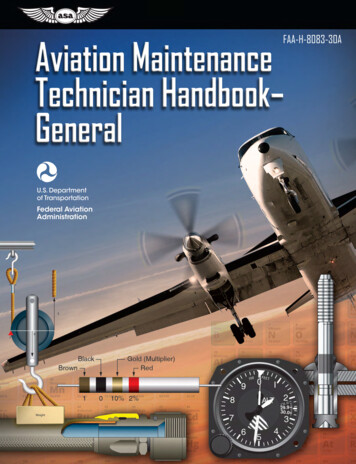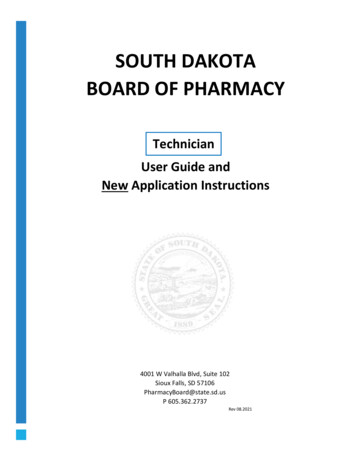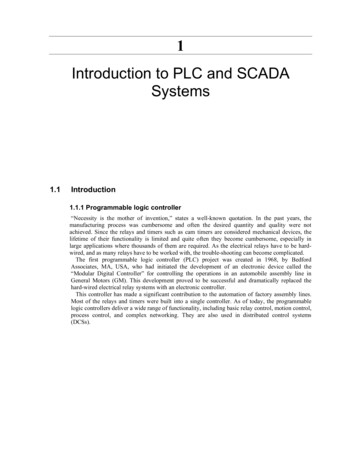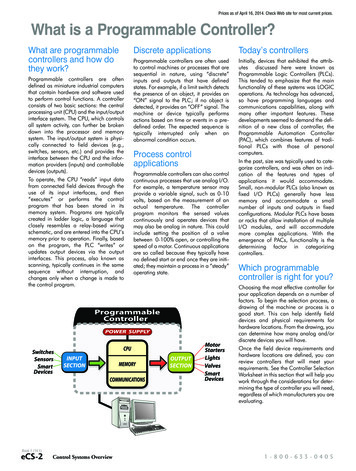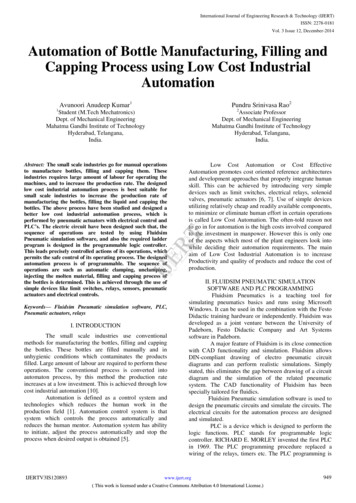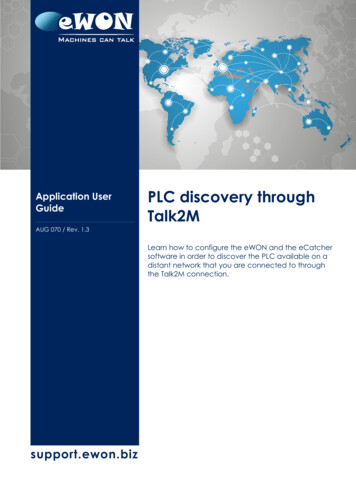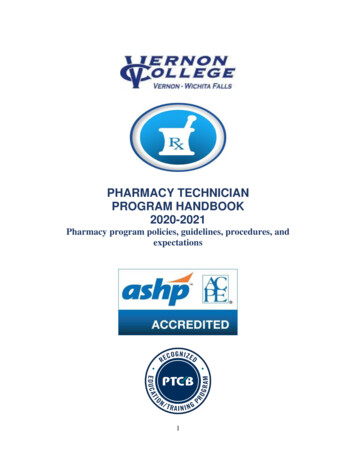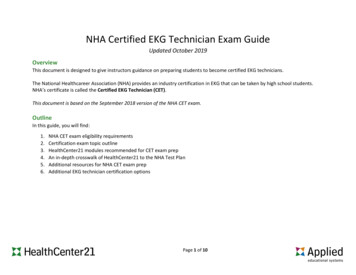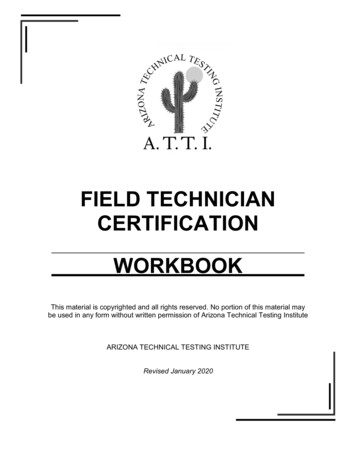
Transcription
2022 EDITIONPLC TECHNICIAN HANDBOOKPractical Guide to Programmable Logic Controllers
PLC TECHNICIAN HANDBOOKPractical Guide to Programmable Logic Controllerswww.gbctechtraining.com 2022 George Brown College160 Kendal Ave, Toronto, ON M5R 1M3
PREFACEPLCs have become an integral part of manufacturing in the twenty-first century and now dominate industrialautomation. To have a meaningful and successful career in the field requires a thorough understanding of thekey foundational skills and theoretical concepts of PLCs.The PLC Technician’s Handbook was developed to be a compact collection of fundamental content forpracticing automation and PLC technicians to reference through their career. The handbook is broken downinto three sections for easy reference: first, a series of articles including basic programming & tips andcommon practices, second, programming examples, and third, supplemental information such as instructionsets of the main ladder logic programming commands and important schematic symbols.Special thanks to Dwayne Nehls, Shimona Babb and Surajit Barua for their valuable assistance andcontribution to the creation of the handbook.We hope that this handbook helps you develop a fuller understanding and practice with PLCs and becomesa useful reference to you in the future.3
TABLE OF CONTENTS1. PLC Technician HandbookGENERAL OVERVIEW OF PLCSWhat are the essential elements of a PLC system? . . . . . . . . . . . . . . . . . . . . . . . . . . . . . . . 5How PLCs are applied in various industries. . . . . . . . . . . . . . . . . . . . . . . . . . . . . . . . . . . . . 8The evolution of PLCs. . . . . . . . . . . . . . . . . . . . . . . . . . . . . . . . . . . . . . . . . . . . . . . . . . . . . 10BASICS OF PROGRAMMINGDifferent types of PLC programming languages. . . . . . . . . . . . . . . . . . . . . . . . . . . . . . . . . 13Basic Instructions and Operation of a PLC. . . . . . . . . . . . . . . . . . . . . . . . . . . . . . . . . . . . . 17Time Driven routine segments. . . . . . . . . . . . . . . . . . . . . . . . . . . . . . . . . . . . . . . . . . . . . . . 19Event Driven program segments. . . . . . . . . . . . . . . . . . . . . . . . . . . . . . . . . . . . . . . . . . . . . 21Counters . . . . . . . . . . . . . . . . . . . . . . . . . . . . . . . . . . . . . . . . . . . . . . . . . . . . . . . . . . . . . . . 22TIPS AND COMMON PRACTICESSCADA, what is it and how does it work. . . . . . . . . . . . . . . . . . . . . . . . . . . . . . . . . . . . . . . 24File based addressing. . . . . . . . . . . . . . . . . . . . . . . . . . . . . . . . . . . . . . . . . . . . . . . . . . . . . 26Reducing Scan time . . . . . . . . . . . . . . . . . . . . . . . . . . . . . . . . . . . . . . . . . . . . . . . . . . . . . . 352. Program ExamplesPLC Timer Instructions . . . . . . . . . . . . . . . . . . . . . . . . . . . . . . . . . . . . . . . . . . . . . . . . . . . . 44Decision Making . . . . . . . . . . . . . . . . . . . . . . . . . . . . . . . . . . . . . . . . . . . . . . . . . . . . . . . . . 493. Supplemental ContentCommon PLC Field Devices and Schematic Symbols. . . . . . . . . . . . . . . . . . . . . . . . . . . . 57Number Systems and Codes used with PLC . . . . . . . . . . . . . . . . . . . . . . . . . . . . . . . . . . . 61Core Instruction Set. . . . . . . . . . . . . . . . . . . . . . . . . . . . . . . . . . . . . . . . . . . . . . . . . . . . . . . 764
A General Overview of PLCsWHAT ARE THE ESSENTIAL ELEMENTSOF A PLC SYSTEM?The world of manufacturing has been changing rapidly over the past decade. Processes are largely automatedand as a result, the quality of products that are produced and the efficiency of systems that produce them isat an unprecedented level. Despite these changes, programmable logic controllers have remained a criticalcomponent of these systems despite being invented in the 1960s.PLCs come in a variety of sizes and with different capabilities, but all include the following six essential systems: Central processing unit Output assembly Rack or mounting Power supply Input assembly Programming unitHere’s an overview of each and what they do.Processor or Central Processing Unit (CPU)Often referred to as the “brains” of the PLC, the processor or central processing unit is responsible forthe execution of commands. The industry has made an effort to use a standardized list of programminglanguages, namely: Structured Text Ladder DiagramPROCESSORRUN Sequential Function ChartInstruction List Function Block diagramRS232BATRUN I/OFORCEOKREMPROGIn spite of aforementioned list of languages beingused, it’s important to note that each manufacturerhas a different method of implementing the code.Rack or MountingThough not a universal truth, most medium to largePLC systems are assembled so that their individualcomponents (things like the CPU or processor, theI/O, and power supply) are held together within amounting or rack. Smaller PLC systems often containall of the components into one compact housing(often referred to as a shoebox, or brick).ProcessorPLC TECHNICIAN HANDBOOK5
What Are the Essential Elements of a PLC System?Input AssemblyINPUTIn terms of functions, the input assembly has two.The first is to receive external signals from fielddevices and control stations (switches, sensors).The second is to display the input point 2131415Output AssemblyOutputs are the pieces of equipment used by thePLC to execute the commands, and are typicallyused to control a manufacturing process (motors,pumps, actuators, lights, etc.).There are two types of I/O: Analog I/O andSpecialty I/O. The differences between the two areoutlined below.Input/Output Interface1.Analog I/O refers to inputs and outputs that are responsible for a range (e.g. the running speed ofa motor). This type of input operates based on continuous change of variable ranges (temperature,pressure, etc.) In this case, the output would include setting the speed of the motor.2.As the name implies, Specialty I/O performs specific tasks, controlling things like high speed counters.Digital I/O operates in using a binary change (yes/no or on/off).The PLC Technician program uses the PLCLogix simulation software to teach students about the I/O assembly.The image above is an example of the software’s interface, containing two discrete input modules, two discreteoutput modules, two TTL modules for BCD control and display, and two analog modules.Power Supply If the CPU is the brains of the PLC, then certainly the power supply is the digestive system, commonly supplyingthe unit with a 24VDC or 120VAC line voltage. The power supply status is continuously monitored and caninclude a switch for selecting a particular programming mode. Thanks to the power supply’s integral lithiumbattery, in the event of a power failure the contentsstored in memory will not change from what they werePOWERprior to the loss of power.Programming Unit, Device, or PC/SoftwareThe modern PLC is programmed using a programmeror software that is built using a PC or laptop and thenloaded into the PLC. PLC software’s big advantageis that they can run simulations to see how a PLCsystem will perform in a virtual environment. RSLogixis one of the most popular simulation tools today.At George Brown College, our students learn usingthese same virtual environments. We use PLCLogixsoftware, which emulates RSLogix and provides thePower SupplyPLC TECHNICIAN HANDBOOK6
What Are the Essential Elements of a PLC System?ability to test and practice PLC programs. Students can apply the knowledge acquired from this program inthe real world PLC environments.PLCs Are More Relevant than EverIn truth, it’s difficult to imagine a world in which PLCs did not exist. The manufacturing process wouldcertainly not be what it is today, and would likely rely more heavily on greater quantities of human capitalto achieve similar levels of production. Even though the base technology responsible for the typical PLC isdecades old, PLCs remain a crucial component to manufacturing, robotic and automated systems.PLC TECHNICIAN HANDBOOK7
HOW PLCS ARE APPLIED IN VARIOUSINDUSTRIESIn the most basic terms, a programmable logic controller (PLC) is a computer that’s equipped with amicroprocessor, but has no keyboard, mouse, or monitor. Though this description might make it seem like PLCssuffer from limited functionality, quite the opposite is true. In fact, PLCs are built to drive the most complicatedmanufacturing processes and withstand very harsh industrial environments. This article will examine how thesesophisticated machines are used in different industries.Oil IndustryPublic opinion may be shifting away from fossil fuels in favor of more ecologically friendly alternative energysources, but there is still a strong demand for the extraction of oil and natural gas. Unfortunately, many ofthe world’s remaining reserves are difficult to access, meaning that companies are pivoting away from thehistorically simple, vertically drilled, single well operations to multi-well operations made possible by directionalor non-vertical drilling. While this process is more efficient (multi-well operations allow companies to drill morethan one well at each site, meaning that operations can be centralized and less impact to the surroundingenvironment), it is also more complicated, so a more robust system is needed to control the site’s equipment.For accurate readings of inputs and outputs and to control the multitude of valves, pumps, and sensors thatallow each well and well pad to operate safely is controlled by its own PLC. PLCs are often paired with a HumanMachine Interface, or HMI, that allows users to monitor the health of the system, manually override controls,view system alarms, or get a glimpse of the system in operation in real time.PLCs allow resource gathering operations to scale up in size with relative ease, since additional PLCs can beadded to the system as new well pads are added. PLCs and HMI systems also help maintenance crews quicklyidentify potential issues on site, resulting in less wasted time performing system diagnostics. Glass IndustryWhile PLCs can efficiently control actuators and valves and perform actions based on data gathered by sensors,these are not the only uses for PLCs in an industrial setting. In fact, the glass industry has widely used PLCs formany years to help manage the precise material ratios required by the production process. The manufacturingof glass is a surprisingly complicated endeavor and is largely made possible in part by the robust data gatheringcapabilities and advanced quality control afforded by PLC technology when paired with a Distributed ControlSystem (DCS). At one point, glass manufacturers relied exclusively on their DCS for their operations, but theassociated high cost of these systems propagated a need for a less costly alternative.In recent years, the equipment used in the manufacture of glass has become more sophisticated, furtherincreasing the demand for PLC solutions that are based on a DCS, which in turn is driving the demand fortechnicians who have completed PLC programming courses. Cement IndustryMuch like the production of glass, the cement industry relies heavily on equipment and software capable ofmixing various raw materials with consistency so that the quality of the finished product is at a consistently highPLC TECHNICIAN HANDBOOK8
How PLCs Are Applied In Various Industrieslevel. The role of the PLC in this industry varies, but in particular, PLCs control ball milling, coal kiln, and shaftkiln operations.Under ControlAdmittedly, the above represents just a few of the industries that rely on PLCs in the manufacture of theirproducts. PLCs can be found in most factories when automation is used including those that mass producefood, vehicles, textiles and more.PLC TECHNICIAN HANDBOOK9
THE EVOLUTION OF PLCSNowadays, with almost every service imaginable available to us on our smartphone, it’s difficult to envisionwhat technology was like before the invention of a single controller. For factories and manufacturing plants, theinvention of programmable logic controllers (or PLCs) revolutionized the industrial automation process, as itscutting-edge technology replaced a complicated system of electromagnetic relays with a singular controller.In industrial workplaces, PLCs are still the preferred choice over other systems. The system has evolved toincorporate modern technologies, while maintaining the durability of the design to withstand the conditions in afactory setting.In order to gain the best understanding and appreciation of PLCs, it’s important to look at the history of the PLC,how it has evolved, and why it still remains one of the most important automation inventions used today.What Are PLCs?Programmable logic controllers are small industrial computers. Their design uses modular components in asingle device to automate customized control processes. They differ from most other computing devices, asthey are intended for and tolerant of severe conditions of factory settings such as dust, moisture, and extremetemperatures.Industrial automation began long before PLCs. In the early 1900s until their invention, the only way to controlmachinery was through the use of complicated electromechanical relay circuits. Each motor would need to beturned ON/OFF individually. This resulted in factories needing massive cabinets full of power relays.As industrial automation continued to grow, modern factories of the time needed dozens of motors with ON/OFF switches to control one machine, and all these relays had to be hardwired in a very specific way. PLCs weredeveloped as a solution to have one solid control as an electronic replacement for hard-wired relay systems.First Automotive PLCsIn 1968, the invention of the first PLC revolutionized the automation industry. First adopted by the automotivesector, General Motors began to deploy PLCs into their operations in 1969. Today, PLCs have broadly beenaccepted as the standard automated control system in manufacturing industries.Known as “The Father of the PLC,” Dick Morely first came up with the vision of a programmable controller whichcould work for every job. He put the proposal together on January 1, 1968. Along with the team at his company(Bedford and Associate) they created a design for a unit which would be modular and rugged while using nointerrupts. They called it the 084, which was named after their 84th project.At the same time as the 084, Bill Stone with GM Hydramatic (automatic transmission division of General Motors)was having the same issue: problems with reliability and documentation for the machines in his plant. Hissolution proposed a solid-state controller as an electronic replacement for hard-wired relay systems.For this reason, Morely insists he is not the inventor of the PLC. Morley stated: “the programmable controller’stime was right. It invented itself because there was a need for it, and other people had that same need.”PLC TECHNICIAN HANDBOOK10
The Evolution of PLCSPLCs were designed so that they could easily be understood and used by plant engineers and maintenanceelectricians, using a software called Ladder Logic. Widely used in PLCs today, Ladder Logic is a programminglanguage which uses ladder diagrams which resemble the rails and rungs of a traditional relay logic circuit.The Evolution of PLCs in Industrial AutomationAfter their initial success with the 084, Bedford and Associates changed its name to Modicon PLC, which stoodfor Modular Digital Controller. Modicon 084 became the name associated with the very first PLC.In the next few decades, the PLC evolved in numerous ways to adapt to various environments and integrate thelatest modern technologies.The emergence of competitors who developed similar systems which rivalled Modicon sparked the need fornew innovations. As a result, the development of t
PLCs and HMI systems also help maintenance crews quickly identify potential issues on site, resulting in less wasted time performing system diagnostics. Glass Industry While PLCs can efficiently control actuators and valves and perform actions based on data gathered by sensors, these are not the only uses for PLCs in an industrial setting.

